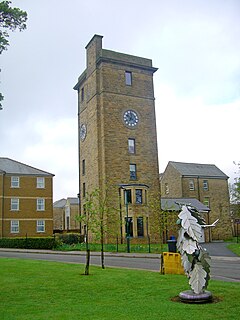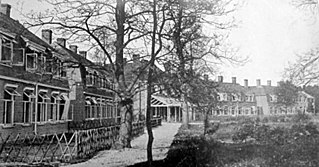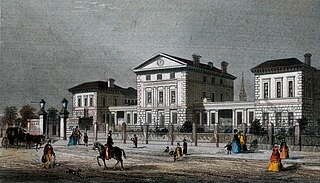
Leamington Spa Hospital is located on Heathcote Lane in Warwick, Warwickshire in England. Originally an isolation hospital, it is now a hospital run by South Warwickshire NHS Foundation Trust specialising in rehabilitation.
The Sheffield Teaching Hospitals NHS Foundation Trust is an NHS Foundation Trust located in Sheffield, England. Founded in 2001 and awarded Foundation status in 2004, the trust covers Sheffield's two major adult hospitals, the Northern General Hospital and the Royal Hallamshire Hospital, as well as the specialised Charles Clifford Dental, Jessop Wing and Weston Park hospitals. The chief executive of the trust is Kirsten Major, and the Medical Director is Dr David Hughes.

The Northern General Hospital is a large teaching hospital and Major Trauma Centre in Sheffield, England. Its departments include Accident and Emergency for adults, with children being treated at the Sheffield Children's Hospital on Western Bank. The hospital is managed by the Sheffield Teaching Hospitals NHS Foundation Trust.

Highlands Hospital was a hospital in Winchmore Hill, in the London Borough of Enfield. The hospital closed in 1993, and the site was developed for residential accommodation, although many of the original buildings remain. The site is designated a conservation area and the former ambulance station is a grade II listed building.

The University Hospital of South Manchester NHS Foundation Trust is a defunct NHS foundation trust that previously operated Wythenshawe Hospital, a major acute teaching hospital in Wythenshawe, Manchester. Many of the services and facilities previously at Withington Hospital were transferred to Wythenshawe in 2004. It provided services for adults and children at Wythenshawe Hospital and Withington Community Hospital. It runs Buccleuch Lodge Intermediate Care Unit and the Dermot Murphy Centre in Withington, and the Specialised Ability Centre in Sharston.

Royal Canberra Hospital was the first hospital in Canberra, the capital of Australia. It opened in 1914 on the Acton Peninsula, as the Canberra Community Hospital. It grew to become the major hospital in Canberra before being closed in 1991 and later demolished in 1997.

The King Edward VII Orthopaedic Hospital was a hospital in the Rivelin Valley area of Sheffield, England. The hospital closed in 1992 and the building has been converted into residential apartments.

Horton Hospital formerly called Horton Asylum was a large psychiatric hospital in the Horton area of Epsom, Surrey.

The Manor Hospital, formerly The Manor Asylum and The Manor Certified Institution was a mental handicap and psychiatric hospital in Horton, near Epsom, Surrey, United Kingdom

Lodge Moor Hospital is a former isolation hospital on Redmires Road in the Lodge Moor area of the City of Sheffield, England. The hospital which opened in 1888 and closed in 1994 initially treated Smallpox but soon broadened its treatment to other infectious diseases and in its latter years expanded to provide more general nursing, notably spinal injuries and chest medicine. At the time of closure, the hospital was operated by the Central Sheffield University Hospitals NHS Trust.

Ruchill Hospital was a fever hospital in the Ruchill area of Glasgow, Scotland. The hospital was closed in 1998 and was sold to Scottish Enterprise in July 1999. It was managed by NHS Greater Glasgow.

King's Cross Hospital, often shortened to King's Cross is a hospital in Dundee, Scotland. It is managed by NHS Tayside.

Joyce Green Hospital was a hospital near Dartford, Kent, England. It opened in 1903 as an isolation hospital. In later years it was a training hospital. The hospital was closed in 2000 and the buildings were demolished. The greenspace where the hospital used to stand is known as Joyce Green.

The former Dispenser's House of Diamantina Hospital is now the heritage-listed Diamantina Health Care Museum at Cornwall Street, Woolloongabba, City of Brisbane, Queensland, Australia. It was designed by Thomas Pye of the Queensland Government Architect's Office and built in 1908 by W Chaplain. It was added to the Queensland Heritage Register on 3 July 2007.

Herman Kiefer Hospital was a city-owned hospital in Detroit Michigan, from 1911 to 2013. It was founded to serve as a public health hospital; to combat rampant infectious diseases, such as tuberculosis, diphtheria, scarlet fever, mumps, measles, and other diseases. It was named after Herman Kiefer, a prominent local physician known for treating the poor.
Catherine-de-Barnes Isolation Hospital was a specialist isolation hospital for infection control in Catherine-de-Barnes, a village within the Metropolitan Borough of Solihull in the English county of West Midlands.
The Detroit Health Department has provided public health services, and has partnered with neighborhoods and community stakeholders, for over 100 years. The department was able to grow from its focus on communicable diseases to one that had over 40 programs and services at one point. When budgets began to deteriorate, many of those programs and services ended. With the city on the verge of bankruptcy, most of the department's remaining services were contracted out to a private agency, the Institute for Population Health (IPH). However, upon successful progress post-bankruptcy the City of Detroit was able to take control of many of the services that were transitioned to IPH in 2014 and 2015. In 2015, Mayor Mike Duggan hired Dr Abdul El-Sayed to run the department, and he stayed in that role for a little over a year before leaving to run for Governor of Michigan. In February 2017, Dr. Joneigh Khaldun, a practicing emergency physician and former Chief Medical Officer of the Baltimore City Health Department, was appointed to lead the department.

The Pinewood Hospital was a hospital in Pinewood, near Crowthorne, England, for the treatment of people suffering from tuberculosis. It was located in a pine wood as pine trees were thought to be beneficial in the treatment of the disease. It opened as the London Open Air Sanatorium in 1901 before becoming the Pinewood Sanatorium. It treated casualties of the First and Second World Wars and after the second, began to treat general thoracic patients as tuberculosis became less prevalent. It closed in 1966.

A fever hospital or isolation hospital is a hospital for infectious diseases such as scarlet fever and smallpox. Their purpose is to treat affected people while isolating them from the general population. Early examples included the Liverpool Fever Hospital (1801) and the London Fever Hospital (1802). other examples occurred elsewhere in the British Isles and India

The Edinburgh City Hospital was a hospital in Colinton, Edinburgh, opened in 1903 for the treatment of infectious diseases. As the pattern of infectious disease changed, the need for in-patients facilities to treat them diminished. While still remaining the regional centre for infectious disease, in the latter half of the 20th century the hospital facilities diversified with specialist units established for respiratory disease, ear, nose and throat surgery, maxillo-facial surgery, care of the elderly and latterly HIV/AIDS. The hospital closed in 1999 and was redeveloped as residential housing, known as Greenbank Village.


















